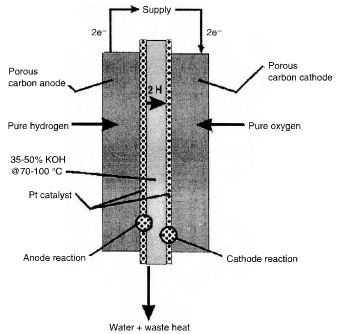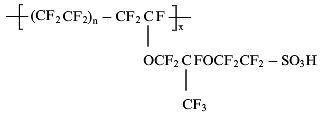Alkaline fuel cell (AFC): This type of fuel cell uses 35-50% KOH as the electrolyte at about 70-100%C. Water is produced at the anode twice as fast as it is used up at the cathode. The cathode is the electrically positive terminal and it is towards this positive terminal that the electrons flow.
Anode H2+2(OH)– →2H2O+2e–
Cathode O2/2+H2O+2e– →2(OH)–
Cell H2+O2/2 →H2O

fig.23.8-Alkaline fuel cell
A schematic cell is shown in figure 23.8. Since the KOH electrolyte absorbs CO2, it is necessary to use a pure H2 source, so a reformate cannot be used. On-board H2 storage causes no emissions and alkali doped carbon nanotubes have a high storage capacity.
Alkaline cells are made by Alternative fuel systems Ltd, slindold, UK.
Proton exchange membrane fuel cell (PEMFC): This is also called the solid polymer fuel cell and the direct methanol fuel cell is included in this classification. These cells use a solid perfluorinated sulfonated polymer ion exchange emebrane in the form of a thin plastic film, which serves as the electrolyte in the PEM fuel cell operating at 50-100C.

The polymer membrane only conducts H+ when fully hydrated and one solution to this problem has been to use carbon fiber wicks. SGL carbon is making fiber based gas diffusion layers in a roll form. The cell is sensitive to low levels of CO, which can be removed by a Pt/Ru catalyst, but the high cost restricts use. However, a later technique to increase the surface area has reduced the cost by a factor of 75.
The cell must be operated below 100C to ensure that the by-product H2O does not evaporate faster than it is produced and the membrane is hydrated. A proton exchange membrane permits the H+ generated at the anode to pass through to the cathode where they combine with O2 to form H2O.
The reactions can be represented by:
Anode H2 →2H+ +2e‑
Cathode O2/2 +2H+ +2e– →H2O
Cell H2+O2/2 →H2O
PEM fuel cells are manufactured by Allied Signal aerospace, analytic power, energy partners, Fuel cell energy inc., H power corp., Ida tech, international full cells and proton energy systems Inc. in the USA; Ballard power systems, in Canada; Daimler Benz and Siemens AG in Germany; Alternative systems Ltd. In the UK and de Nora s.p.a in Italy.